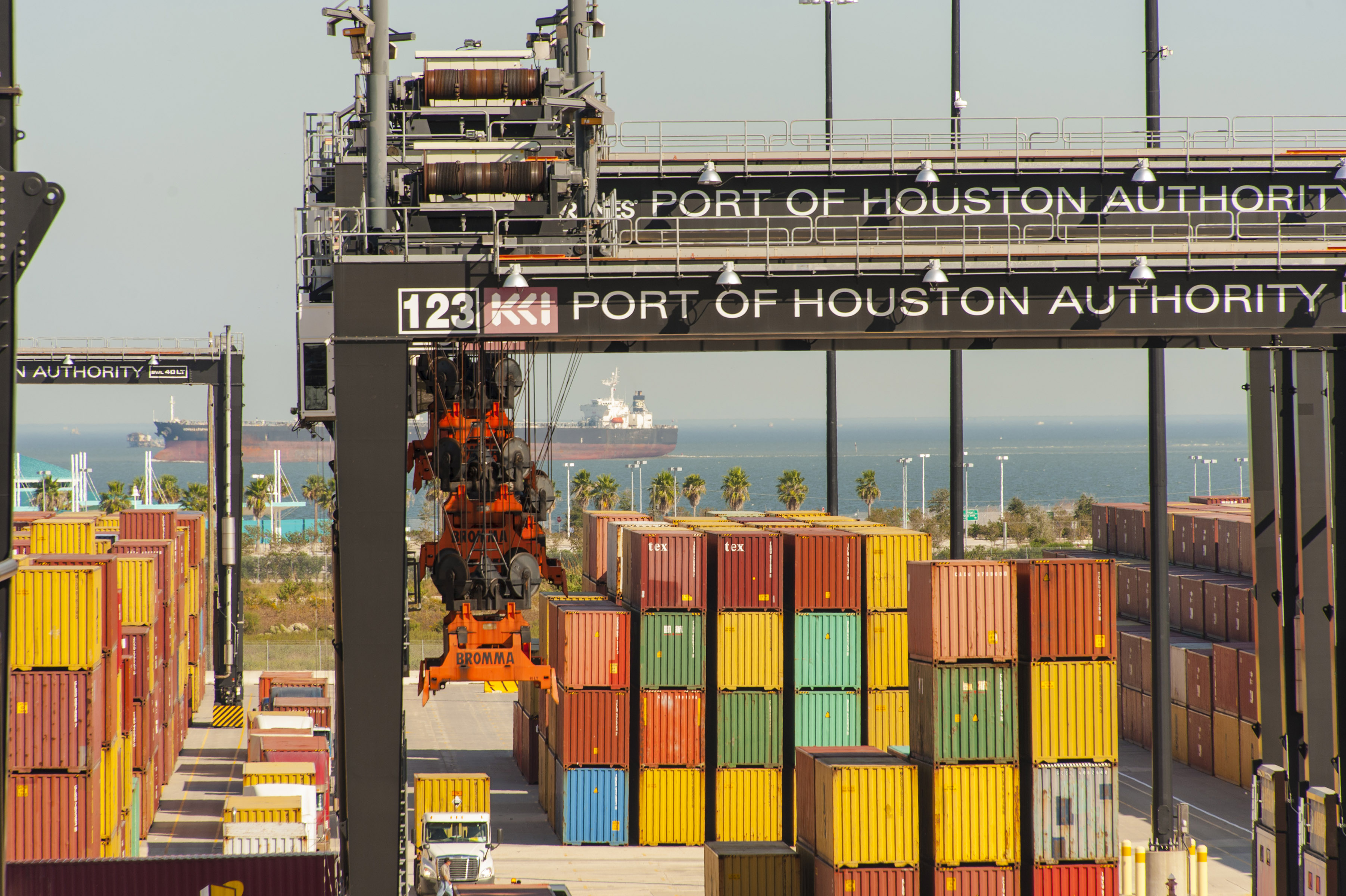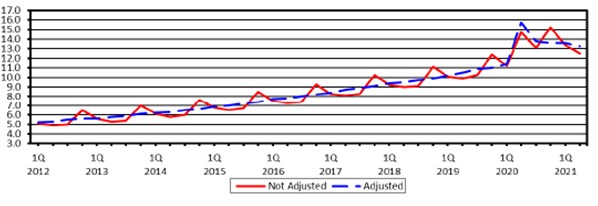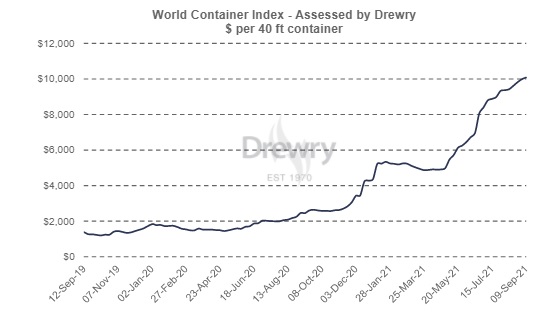The "Perfect Storm" of Global Supply Chain Disruption and What it Means for Houston
Published Sep 15, 2021 by Maggie Martin
Global supply chain woes stemming from the pandemic continue to drag on, creating chaos in international markets. Many companies anticipate the issue will extend into next year. UPS, for instance, recently encouraged consumers to order Christmas presents now. Kroger and Toyota have also voiced concerns, as well as Walmart.
But it's not all bad news for Houston, the country's largest export market. In fact, container traffic at the Port of Houston is on track to set a record this year.
We asked Margaret Kidd, Program Director for Supply Chain & Logistics Technology at the University of Houston's College of Technology, to explain the factors driving the supply chain crunch and what it means for Houston.
What’s going on with the global supply chain and why?
COVID-19 continues to play havoc with global supply chains impacting the efficient flow of trade. An insatiable demand by U.S. consumers has driven e-commerce in Q2 2021 on an adjusted basis, to account for 13.3% of total sales. There's no question that the exponential growth of e-commerce in an extremely short time frame has turned a supply demand imbalance into the perfect storm within a storm.
The other part of the storm is the domino effect that begins with the temporary closure of manufacturing facilities in Asia as a result of COVID. It takes time to bring those facilities back online and ramp up production. Illustrative of this point is the COVID breakouts over the last several months in both China and Vietnam. Those supply chains have seen a number of service disruptions within transportation modes. Over this summer we witnessed the temporary closure at Meishan terminal at Ningbo-Zhoushan Port and Yantian International Container Terminal at Shenzhen Port. The World Shipping Council in 2020 ranked these two ports number 3 and 4 globally. The significance of these temporary closures ultimately create enormous bottlenecks further down the supply chain.
U.S. ports are all working through record trade and congestion. U.S. West Coast ports have been particularly hard hit. Currently, there are 40 ships anchored in LA/LB environs, according to Marine Traffic.
While Houston has not suffered the massive congestion that we are seeing at West Coast ports, they have had to work through capacity constraints and quickly resolve the failure of their gates for several days at the Barbours Cut and Bayport terminals over the summer. Outside of congestion within U.S. ports, the acute shortage of empty containers for export and cost of containers, along with shortage of chassis, drivers and workers, has served to continue delays within supply chains.
Ultimately, trade disruption impacts both U.S. manufacturers and consumers alike. For manufacturers, it could be the lack of availability of critical component parts, such as chips for the auto industry. As a result, some U.S. automakers have halted production lines and focused on higher end vehicles. Consumers, on the other hand, have faced items that are out of stock, unavailable, limited selection options and higher prices. For manufacturers, wholesalers and consumers, the disruptions also mean delays.
How much longer will these shortages last?
Trade disruptions and shortages will continue until the COVID curve is flattened and under control globally and the demand-supply of trade balances out. While the CDC provides that 62.7% of the U.S. population 12 and older has been fully vaccinated, it is necessary to consider the vaccination rates of our global trading partners along with the interconnectedness of our economies.
There is no question that consumers who came out of lockdown last year, with the boost of federal stimulus check, went on massive spending sprees. The rebound of the job market also boosted consumer confidence. We see that in the e-commerce data and port throughput numbers.
In general, we should begin to see less shortages in 2022 as more become vaccinated, consumers normalize spending, and manufacturing remains operational.
There remain trouble spots with major trading partners such as Vietnam, which is ranked number 6 by the U.S. census and represents 56.1 billion in imports to the U.S. to date. In addition to low country vaccination rates, Ho Chi Minh City remains on complete lockdown. Clearly, this impacts manufacturing and exports.
What’s the impact to Houston businesses?
Houston has been, and remains, a beneficiary of port congestion on the U.S. West Coast. Port Houston continues to report record trade numbers. In July, they reported a record 297,621 TEUs, an increase of 27% compared to July 2020, and an increase of 224 TEUs from the previous all-time record set in March 2021. This record trade trickles down to drayage drivers, trucking firms, third party logistics firms, warehouses, and distribution centers – people are making money.
The relocations of corporate offices of Tesla, Hewlett Packard Enterprise and Oracle to Texas positively impact trade through the Houston region. Houston Purchasing Managers Index (PMI) of 57.5 indicates improvement, along with home sales and sales tax collection.
Auto distributors should be happy that July brought an uptick in auto imports by 57% from last July. Certainly, the rebound of the price of oil from $20.06 in April 2020 to $68.50 in August 2021 has been a positive respite for the oil and gas sector in Houston. For instance, Houston is a beneficiary of drilling activity in Guyana where ExxonMobil just had their 20th discovery.
We have seen an enormous uptick in jobs in supply chain and logistics as a result of record trade and positive economic growth. In my role as program director, supply chain & logistics technology program at University of Houston, I received a record number of request from area employers in August. Typically, this is not a month when I hear from hiring managers.
On the reverse side of this is the increased cost of transporting an 8 x 40 foot container, along with availability of containers. According to the Drewry World Container index, the cost of shipping one container in September 2019 was less than $2000. In September 2021, the cost is in excess of $10,000. This cost gets passed on to the logistics budgets of shippers and then to the ultimate purchaser of goods.
Last year, we talked with you about actions companies could take to strengthen that chain and make it even more resilient in the long term. Now, 18 months since the pandemic hit Houston, is Houston’s supply chain more resilient?
Texas in general, and Houston in particular, are resilient geographies, with resilient human capital. This has been illustrative throughout our history. Most recently, the big freeze in February.
The investment in infrastructure in the region certainly bodes well for resiliency. The launch of Project 11 to widen and deepen the Houston Ship Channel provides capacity for two-way traffic to move goods more safely and efficiently. As the supply chain is an interconnection of many organizations and individuals, the expansion of the Houston Ship Channel is a major key to regional resilient supply chain. Additionally, the expansion of industrial real estate for distribution centers over the last decade has added to the resiliency of the Houston region in terms of clearly leading as a global logistics hub.
See our September edition of Houston: Economy at a Glance for the latest data and information on our region's economy. Learn more about Houston's logistical and distribution channels.
 The Houston Report
The Houston Report


















